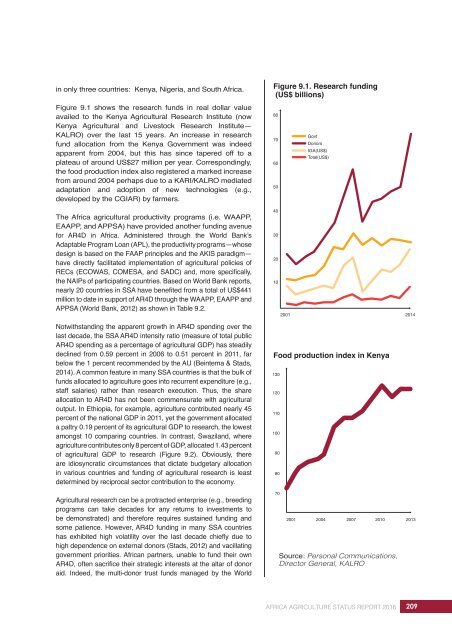AFRICA AGRICULTURE STATUS REPORT 2016
AASR-report_2016-1
AASR-report_2016-1
You also want an ePaper? Increase the reach of your titles
YUMPU automatically turns print PDFs into web optimized ePapers that Google loves.
in only three countries: Kenya, Nigeria, and South Africa.<br />
Figure 9.1 shows the research funds in real dollar value<br />
availed to the Kenya Agricultural Research Institute (now<br />
Kenya Agricultural and Livestock Research Institute—<br />
KALRO) over the last 15 years. An increase in research<br />
fund allocation from the Kenya Government was indeed<br />
apparent from 2004, but this has since tapered off to a<br />
plateau of around US$27 million per year. Correspondingly,<br />
the food production index also registered a marked increase<br />
from around 2004 perhaps due to a KARI/KALRO mediated<br />
adaptation and adoption of new technologies (e.g.,<br />
developed by the CGIAR) by farmers.<br />
Figure 9.1. Research funding<br />
(US$ billions)<br />
The Africa agricultural productivity programs (i.e. WAAPP,<br />
EAAPP, and APPSA) have provided another funding avenue<br />
for AR4D in Africa. Administered through the World Bank’s<br />
Adaptable Program Loan (APL), the productivity programs—whose<br />
design is based on the FAAP principles and the AKIS paradigm—<br />
have directly facilitated implementation of agricultural policies of<br />
RECs (ECOWAS, COMESA, and SADC) and, more specifically,<br />
the NAIPs of participating countries. Based on World Bank reports,<br />
nearly 20 countries in SSA have benefited from a total of US$441<br />
million to date in support of AR4D through the WAAPP, EAAPP and<br />
APPSA (World Bank, 2012) as shown in Table 9.2.<br />
Notwithstanding the apparent growth in AR4D spending over the<br />
last decade, the SSA AR4D intensity ratio (measure of total public<br />
AR4D spending as a percentage of agricultural GDP) has steadily<br />
declined from 0.59 percent in 2006 to 0.51 percent in 2011, far<br />
below the 1 percent recommended by the AU (Beintema & Stads,<br />
2014). A common feature in many SSA countries is that the bulk of<br />
funds allocated to agriculture goes into recurrent expenditure (e.g.,<br />
staff salaries) rather than research execution. Thus, the share<br />
allocation to AR4D has not been commensurate with agricultural<br />
output. In Ethiopia, for example, agriculture contributed nearly 45<br />
percent of the national GDP in 2011, yet the government allocated<br />
a paltry 0.19 percent of its agricultural GDP to research, the lowest<br />
amongst 10 comparing countries. In contrast, Swaziland, where<br />
agriculture contributes only 8 percent of GDP, allocated 1.43 percent<br />
of agricultural GDP to research (Figure 9.2). Obviously, there<br />
are idiosyncratic circumstances that dictate budgetary allocation<br />
in various countries and funding of agricultural research is least<br />
determined by reciprocal sector contribution to the economy.<br />
Agricultural research can be a protracted enterprise (e.g., breeding<br />
programs can take decades for any returns to investments to<br />
be demonstrated) and therefore requires sustained funding and<br />
some patience. However, AR4D funding in many SSA countries<br />
has exhibited high volatility over the last decade chiefly due to<br />
high dependence on external donors (Stads, 2012) and vacillating<br />
government priorities. African partners, unable to fund their own<br />
AR4D, often sacrifice their strategic interests at the altar of donor<br />
aid. Indeed, the multi-donor trust funds managed by the World<br />
Food production index in Kenya<br />
Source: Personal Communications,<br />
Director General, KALRO<br />
<strong>AFRICA</strong> <strong>AGRICULTURE</strong> <strong>STATUS</strong> <strong>REPORT</strong> <strong>2016</strong><br />
209


